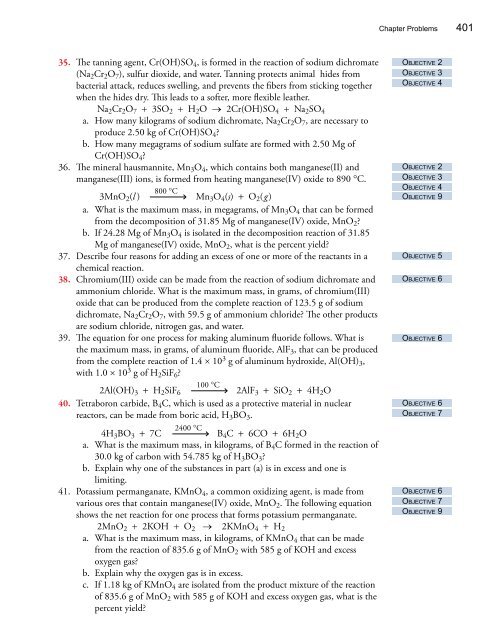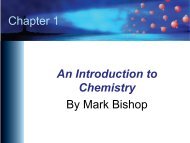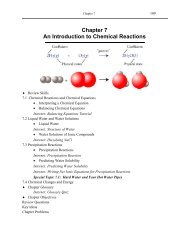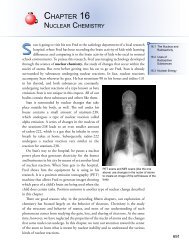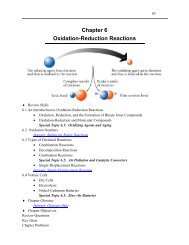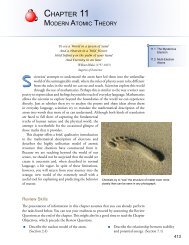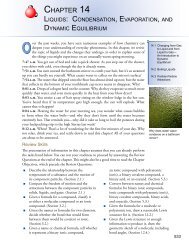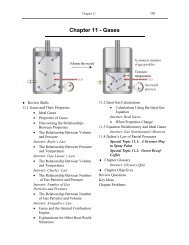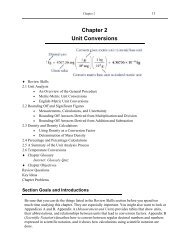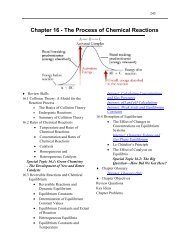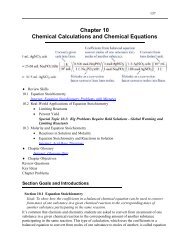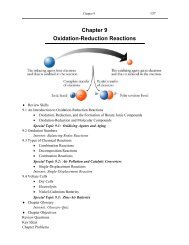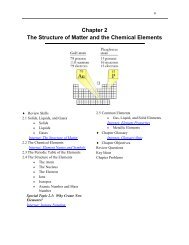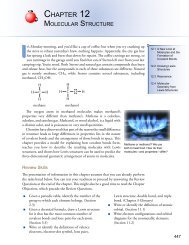Chapter 10 - An Introduction to Chemistry: Chemical Calculations ...
Chapter 10 - An Introduction to Chemistry: Chemical Calculations ...
Chapter 10 - An Introduction to Chemistry: Chemical Calculations ...
Create successful ePaper yourself
Turn your PDF publications into a flip-book with our unique Google optimized e-Paper software.
<strong>Chapter</strong> Problems 401<br />
35. The tanning agent, Cr(OH)SO 4 , is formed in the reaction of sodium dichromate<br />
(Na 2 Cr 2 O 7 ), sulfur dioxide, and water. Tanning protects animal hides from<br />
bacterial attack, reduces swelling, and prevents the fibers from sticking <strong>to</strong>gether<br />
when the hides dry. This leads <strong>to</strong> a softer, more flexible leather.<br />
Na 2 Cr 2 O 7 + 3SO 2 + H 2 O → 2Cr(OH)SO 4 + Na 2 SO 4<br />
a. How many kilograms of sodium dichromate, Na 2 Cr 2 O 7 , are necessary <strong>to</strong><br />
produce 2.50 kg of Cr(OH)SO 4 ?<br />
b. How many megagrams of sodium sulfate are formed with 2.50 Mg of<br />
Cr(OH)SO 4 ?<br />
36. The mineral hausmannite, Mn 3 O 4 , which contains both manganese(II) and<br />
manganese(III) ions, is formed from heating manganese(IV) oxide <strong>to</strong> 890 °C.<br />
800 °C<br />
3MnO 2 (l )<br />
Mn 3 O 4 (s) + O 2 (g)<br />
a. What is the maximum mass, in megagrams, of Mn 3 O 4 that can be formed<br />
from the decomposition of 31.85 Mg of manganese(IV) oxide, MnO 2 ?<br />
b. If 24.28 Mg of Mn 3 O 4 is isolated in the decomposition reaction of 31.85<br />
Mg of manganese(IV) oxide, MnO 2 , what is the percent yield?<br />
37. Describe four reasons for adding an excess of one or more of the reactants in a<br />
chemical reaction.<br />
38. Chromium(III) oxide can be made from the reaction of sodium dichromate and<br />
ammonium chloride. What is the maximum mass, in grams, of chromium(III)<br />
oxide that can be produced from the complete reaction of 123.5 g of sodium<br />
dichromate, Na 2 Cr 2 O 7 , with 59.5 g of ammonium chloride? The other products<br />
are sodium chloride, nitrogen gas, and water.<br />
39. The equation for one process for making aluminum fluoride follows. What is<br />
the maximum mass, in grams, of aluminum fluoride, AlF 3 , that can be produced<br />
from the complete reaction of 1.4 × <strong>10</strong> 3 g of aluminum hydroxide, Al(OH) 3 ,<br />
with 1.0 × <strong>10</strong> 3 g of H 2 SiF 6 ?<br />
<strong>10</strong>0 °C<br />
2Al(OH) 3 + H 2 SiF 6<br />
2AlF 3 + SiO 2 + 4H 2 O<br />
40. Tetraboron carbide, B 4 C, which is used as a protective material in nuclear<br />
reac<strong>to</strong>rs, can be made from boric acid, H 3 BO 3 .<br />
2400 °C<br />
4H 3 BO 3 + 7C<br />
B 4 C + 6CO + 6H 2 O<br />
a. What is the maximum mass, in kilograms, of B 4 C formed in the reaction of<br />
30.0 kg of carbon with 54.785 kg of H 3 BO 3 ?<br />
b. Explain why one of the substances in part (a) is in excess and one is<br />
limiting.<br />
41. Potassium permanganate, KMnO 4 , a common oxidizing agent, is made from<br />
various ores that contain manganese(IV) oxide, MnO 2 . The following equation<br />
shows the net reaction for one process that forms potassium permanganate.<br />
2MnO 2 + 2KOH + O 2 → 2KMnO 4 + H 2<br />
a. What is the maximum mass, in kilograms, of KMnO 4 that can be made<br />
from the reaction of 835.6 g of MnO 2 with 585 g of KOH and excess<br />
oxygen gas?<br />
b. Explain why the oxygen gas is in excess.<br />
c. If 1.18 kg of KMnO 4 are isolated from the product mixture of the reaction<br />
of 835.6 g of MnO 2 with 585 g of KOH and excess oxygen gas, what is the<br />
percent yield?<br />
Objective 2<br />
Objective 3<br />
Objective 4<br />
Objective 2<br />
Objective 3<br />
Objective 4<br />
Objective 9<br />
Objective 5<br />
Objective 6<br />
Objective 6<br />
Objective 6<br />
Objective 7<br />
Objective 6<br />
Objective 7<br />
Objective 9


